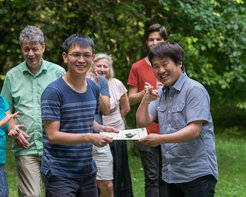Thomas Ertl and Chia-Yu Hu receive Kippenhahn Prize 2015
The prize was established in 2009 and is named in honour of Prof. Rudolf Kippenhahn, former director of MPA, to motivate students to write a good publication. Criterions for the prize are that the student is first author and has contributed substantially to the scientific ideas, calculations and analysis, and the writing of the paper. The committee received five applications and was impressed by the quality of the papers. After careful consideration they decided to award the Kippenhahn prize to two winners.

Thomas Ertl’s paper “A two-parameter criterion for classifying the explodability of massive stars by the neutrino-driven mechanism” introduces a novel criterion to predict the final fate of massive stars – either collapse to a black hole or neutron star formation accompanied by a supernova explosion. Based on simulations of stellar core collapse and neutrino-driven explosions, which he had performed for a huge set of hundreds of stars of different masses and metallicities, Thomas discovered that two parameters in combination, the enclosed mass and the corresponding gradient at the interface of the silicon layer and oxygen-enriched silicium-shell, can do an excellent job as indicators of the “explodability” of a star.

With the paper “Star formation and molecular hydrogen in dwarf galaxies: a nonequilibrium view” Chia-Yu Hu makes a major step forward in understanding star formation in dwarf galaxies. His self-consistent numerical simulations resolve the impact of individual supernova explosions, photoelectric heating, and dust on the non-equilibrium chemo-dynamical structure of the interstellar medium and have reached unprecedented resolution and physical realism. Chia-Yu was able to demonstrate that the cold and dense gas reservoir for star formation in dwarf galaxies is dominated by atomic hydrogen instead of H2. Their star formation rates are mainly regulated by feedback from supernovae.

